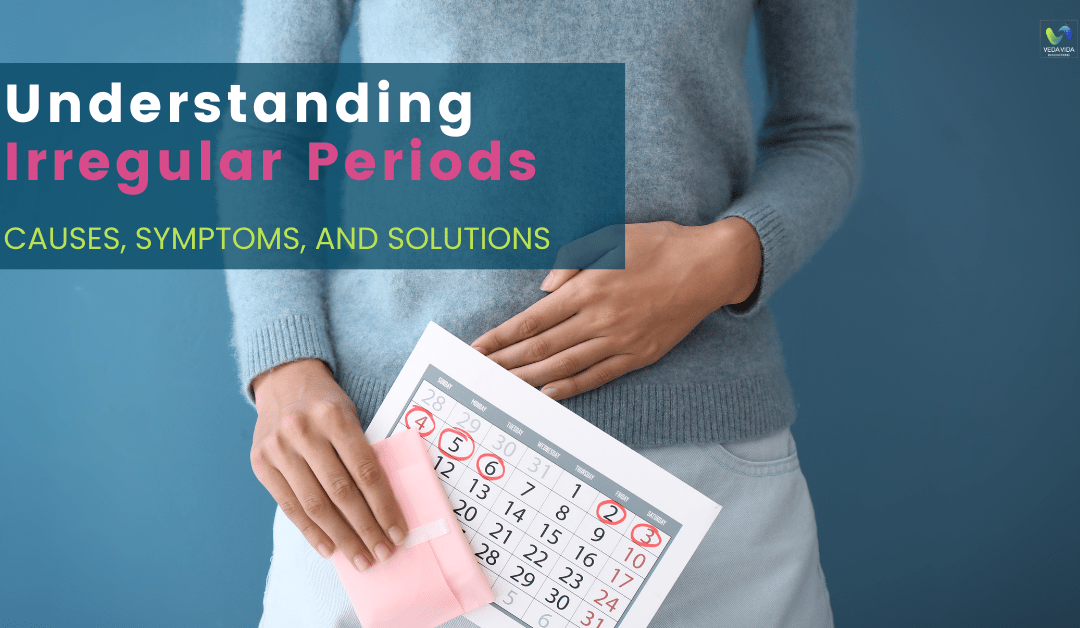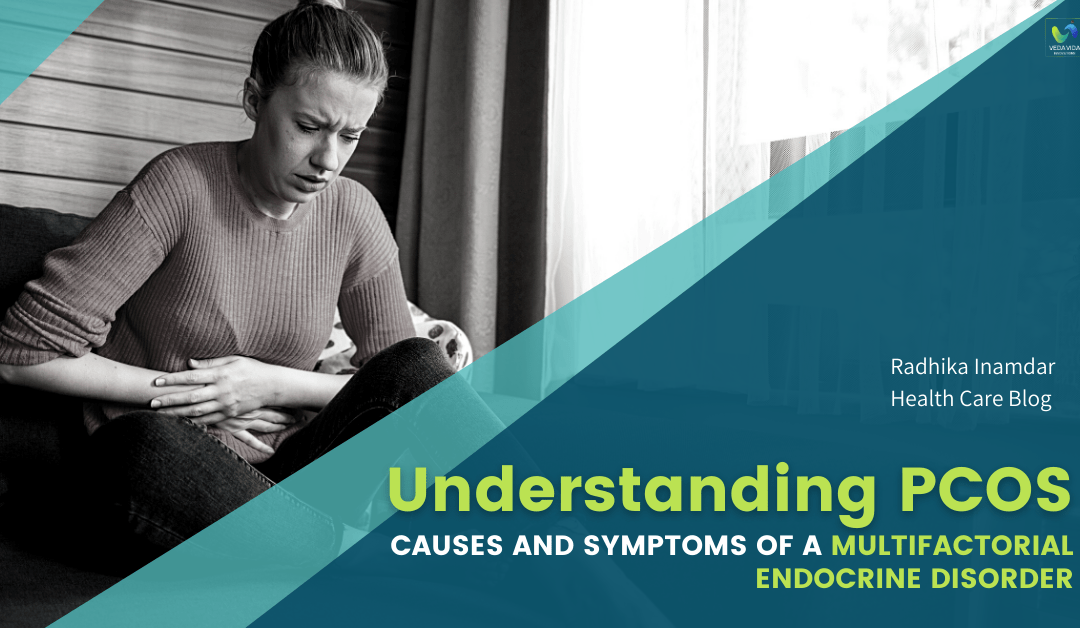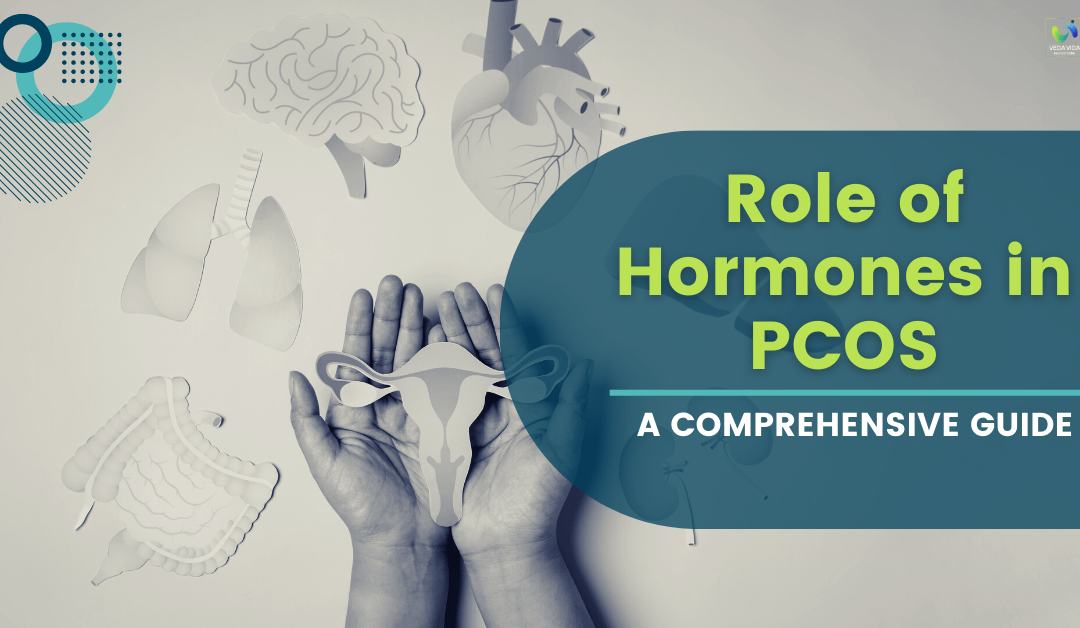
by nikita pustake | 11 Jul, 2023 | Female’s Health
Are you tired of receiving notifications from your period tracker app about irregular periods? Or are you frustrated with your menstrual cycle’s unpredictable behavior? Are your periods arriving like an uninvited obnoxious guest who is not ready to leave? If your periods are arriving unexpectedly or lasting longer than usual, you may be experiencing irregular periods.
Typically, a menstrual period lasts for four to seven days and occurs every 28 days. However, if your menstrual cycle ranges from 21 to 35 days, it is still considered regular. But if you experience any of the following period issues, you may have irregular periods:
- Menstrual cycles occurring less than 21 days or more than 35 days apart
- Skipping periods for three or more consecutive months
- Heavier or lighter bleeding than usual
- Periods lasting more than seven days
- Experiencing pain, cramping, nausea, or vomiting during periods
- Bleeding or spotting between periods, after menopause, or following sex
At Veda-Vida Innovations, we understand the challenges that come with irregular periods. Our Sushumna range of products offers solutions to common period issues.
Here are some of the major period issues that women face:
- Heavy periods (Menorrhagia): If your flow is so heavy that you need to change your tampon or pad every hour for at least an entire day, you may have menorrhagia. This condition can be caused by hormonal imbalances, growths in the uterus, certain IUDs, pregnancy problems, female cancers, medications, endometriosis, thyroid problems, pelvic inflammatory disease (PID), kidney disease, liver disease, and other factors.
- Light periods (Hypomenorrhea): Hypomenorrhea is a condition in which you experience extremely light or scanty blood flow during menstruation. If you produce only 20-30ML of blood instead of the usual 30-80ML, you may have this condition. Hypomenorrhea can be caused by hormonal imbalances, PCOS, stress, birth control pills, hyperthyroidism, sudden weight loss or weight gain, menopause, certain medications, and other factors.
- Infrequent periods (Oligomenorrhoea): If you experience infrequent periods that don’t occur for more than 35 days, have less than nine periods a year, and experience PMS symptoms such as mood swings, tiredness, bloating, and abdominal cramps, you may have oligomenorrhoea. You may notice that the blood is a darker brown shade or is very faint, and small clots are present. This condition can be caused by hormonal imbalances, lifestyle changes, excessive physical activity, being overweight or obese, PCOS, primary ovarian insufficiency, thyroid disorders, diabetes, pelvic inflammatory disease, anatomical defects in the uterus, vagina, cervix, steroid or other medication usage, and other factors.
- Absence of periods (Amenorrhea): Amenorrhea is the absence of menstruation, often defined as missing one or more menstrual periods. Symptoms of this condition include headaches, vision changes, nausea, extra facial hair, hair loss, changes in breast size, milky fluid or discharge from breasts, or no breast development. Amenorrhea can be caused by hormonal imbalances, family history, genetic or chromosomal defects, being severely overweight or underweight, eating disorders, extreme exercise, poor diet, stress, PCOS, some birth control methods, depression medications, chemotherapy, thyroid or pituitary gland issues, blood pressure, hypothalamic disease, uterine scar tissue, pregnancy, breastfeeding, and menopause.
In conclusion, irregular periods are a common issue faced by many women, and it can be caused by a variety of factors ranging from hormonal imbalances to lifestyle choices. However, it’s essential to identify and address the underlying causes to prevent any long-term health complications. With the Veda-Vida Innovations’ Sushumna range of products, you can tackle any menstrual issues effectively and regain control of your cycle. It’s always advisable to consult a medical professional if you’re experiencing any severe or persistent symptoms. Take charge of your menstrual health and live your life to the fullest.

by nikita pustake | 11 Jul, 2023 | Female’s Health
Polycystic Ovary Syndrome (PCOS) is a complex endocrine disorder that affects millions of women worldwide. It is a multifactorial condition that can manifest in different ways and can cause a variety of symptoms that can greatly impact a woman’s quality of life. In this blog, we will discuss the four main characteristics of PCOS, which are anovulation, hyperandrogenism, insulin resistance, and polycystic ovarian morphology.
Anovulation
Anovulation is one of the main characteristics of PCOS. It occurs when an egg does not release from the ovary during the menstrual cycle, which can lead to irregular periods or no periods at all. Women with PCOS may also experience difficulty getting pregnant due to the lack of ovulation. Anovulation is caused by the hormonal imbalances that occur in PCOS, which can disrupt the normal functioning of the ovaries.
Hyperandrogenism
Hyperandrogenism is another hallmark of PCOS. It is a condition in which there is an excess of androgen hormones, particularly testosterone, in the bloodstream. This can cause a variety of symptoms, including acne, hirsutism (excessive hair growth), and male pattern baldness. Women with PCOS may also experience a deepening of the voice and an increase in muscle mass. Hyperandrogenism is caused by the overproduction of androgens in the ovaries, adrenal glands, or both.
Insulin Resistance
Insulin resistance is a common characteristic of PCOS. It occurs when the body’s cells become resistant to the effects of insulin, leading to an increase in insulin production. This can cause a variety of symptoms, including weight gain, fatigue, and an increased risk of developing type 2 diabetes. Women with PCOS may also experience difficulty losing weight, despite a healthy diet and regular exercise. Insulin resistance is thought to be caused by the hormonal imbalances that occur in PCOS, particularly the excess production of insulin and androgens.
Polycystic Ovarian Morphology
Polycystic ovarian morphology is the presence of multiple small follicles in the ovaries. These follicles can be seen on an ultrasound and are a characteristic feature of PCOS. The follicles are surrounded by theca cells, which are responsible for producing androgens. The excess androgen production in PCOS can lead to the development of these follicles. Polycystic ovarian morphology is not always present in women with PCOS, and its absence does not rule out the diagnosis.
In conclusion, PCOS is a complex endocrine disorder that can cause a variety of symptoms and impact a woman’s quality of life. The four main characteristics of PCOS are anovulation, hyperandrogenism, insulin resistance, and polycystic ovarian morphology. If you suspect you may have PCOS, it is important to speak with your healthcare provider to discuss your symptoms and develop a treatment plan that is right for you.

by nikita pustake | 11 Jul, 2023 | Female’s Health
Menopause is a natural biological process that every woman goes through, but it can be a challenging and uncomfortable time. There are typically three stages of menopause that a woman goes through: perimenopause, menopause, and post-menopause. By understanding the symptoms and changes that occur during each phase, women can better manage their physical and emotional health.
Perimenopause is the first stage of menopause and can last for several years. During this stage, your body begins to transition from the reproductive stage of life to menopause. You may experience irregular periods, hot flashes, mood swings, vaginal dryness, urinary issues, and other symptoms as your estrogen and progesterone levels start to drop. Perimenopause can begin as early as your 30s or as late as your 40s, and the experience is different for every woman.
Menopause is reached when you haven’t had a menstrual period for an entire year during the perimenopausal phase. This marks the end of your reproductive years, and your ovaries cease to produce estrogen and progesterone. Symptoms during this stage can include hot flashes, night sweats, mood changes, difficulty sleeping, and other physical and emotional changes.
Post-menopause is the final stage of menopause and begins when a woman has not had a period for one year. During this stage, the symptoms of menopause start to subside, but women may experience new health issues such as increased risk for heart disease, osteoporosis, and other conditions. It is important to maintain a healthy lifestyle and have regular checkups with your doctor to monitor your health.
In addition to the natural physical changes that occur during menopause, women may also experience an increased risk for several conditions such as diabetes, autoimmune disorders, joint pain, hepatitis C, gout, urinary tract infections, vaginal atrophy, and gum disease. It’s important to stay proactive about your health by maintaining a healthy weight, avoiding drugs and alcohol, getting consistent moderate exercise, and staying connected with friends and family.
If you are going through menopause, it’s essential to talk to your doctor about your symptoms and how to manage them effectively. You may also want to consider taking Veda Vida‘s SUSHUMNA-M to support your health and ease your transition through menopause. By taking care of your physical and emotional health, you can have a smooth and empowering journey through menopause.

by nikita pustake | 11 Jul, 2023 | Female’s Health
Polycystic Ovary Syndrome (PCOS)
is a hormonal disorder that affects up to 10% of women of reproductive age. The condition is characterized by the presence of multiple cysts in the ovaries, irregular menstrual cycles, and high levels of male hormones. In this blog, we’ll explore the hormones that play a significant role in PCOS and how they affect the body.
- Insulin
Insulin is a hormone produced by the pancreas that regulates blood sugar levels. Women with PCOS often have high levels of insulin due to insulin resistance, which means the body is not responding to insulin properly. High insulin levels can cause the ovaries to produce more androgens (male hormones), leading to symptoms such as acne, excess hair growth, and irregular periods.
- Androgens
Androgens are male hormones that are also present in women. In PCOS, the ovaries produce too much androgen, which can lead to symptoms such as acne, excess hair growth (hirsutism), and male-pattern baldness. High levels of androgens can also disrupt ovulation, leading to irregular menstrual cycles or a lack of periods.
- Estrogen
Estrogen is a female hormone that plays a crucial role in the menstrual cycle and pregnancy. In PCOS, the balance of estrogen and progesterone is disrupted, leading to irregular periods and difficulty getting pregnant. Some women with PCOS may also have low levels of estrogen, which can cause vaginal dryness and other symptoms.
- Progesterone
Progesterone is a hormone produced by the ovaries after ovulation. It helps regulate the menstrual cycle and prepare the body for pregnancy. Women with PCOS may not ovulate regularly, leading to low levels of progesterone and irregular periods.
- Follicle-stimulating hormone (FSH)
FSH is a hormone produced by the pituitary gland that stimulates the ovaries to produce eggs. In PCOS, the levels of FSH are often lower than normal, leading to irregular ovulation and menstrual cycles.
- Luteinizing hormone (LH)
LH is a hormone produced by the pituitary gland that stimulates the ovaries to produce androgens. Women with PCOS often have high levels of LH, which can lead to excess androgen production and other symptoms.
In conclusion, PCOS is a complex hormonal disorder that involves several different hormones. High levels of insulin, androgens, and LH, as well as low levels of estrogen, progesterone, and FSH, can all contribute to the symptoms of PCOS. If you suspect you have PCOS, it’s essential to speak to your healthcare provider to get an accurate diagnosis and appropriate treatment.



